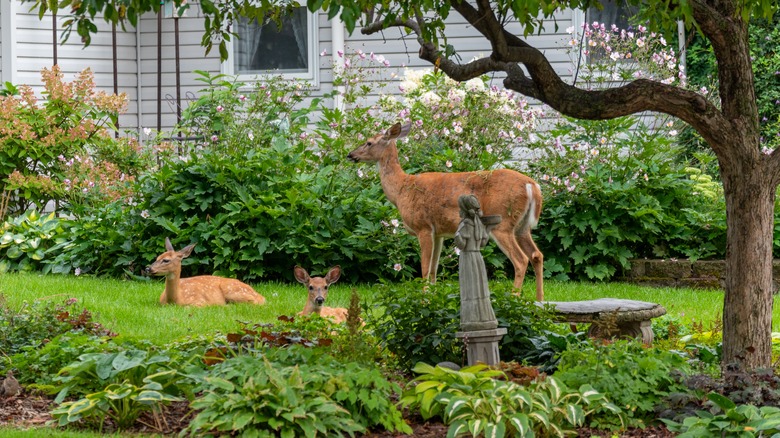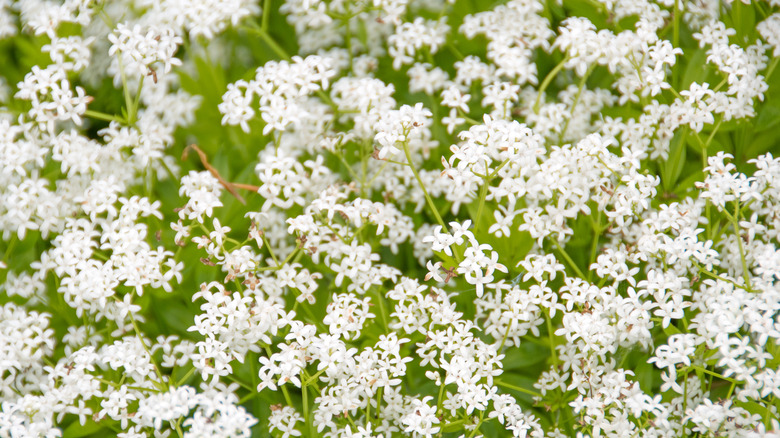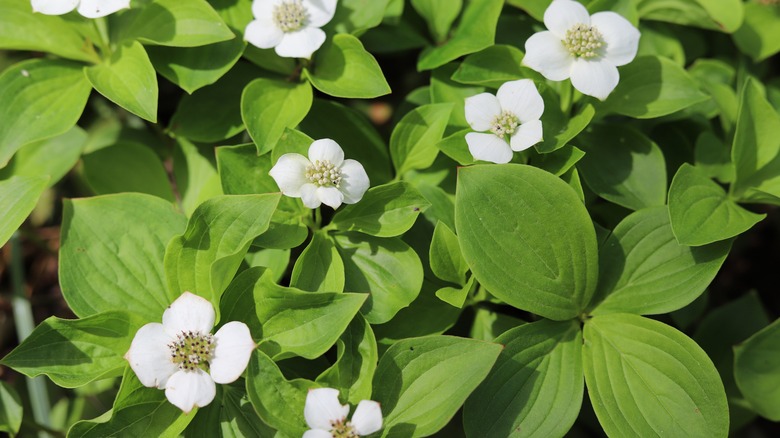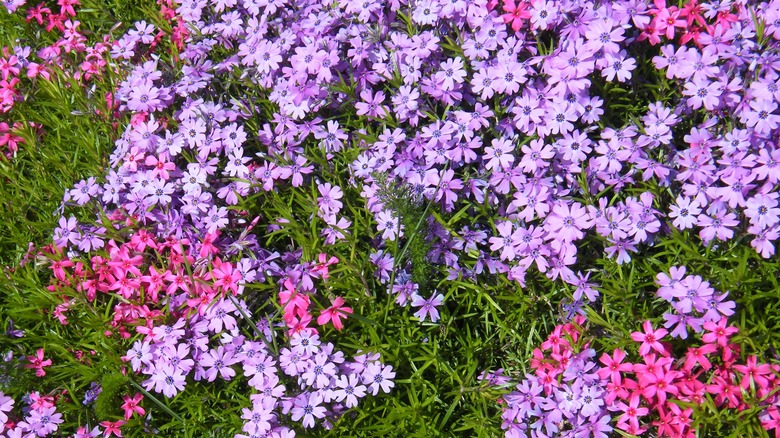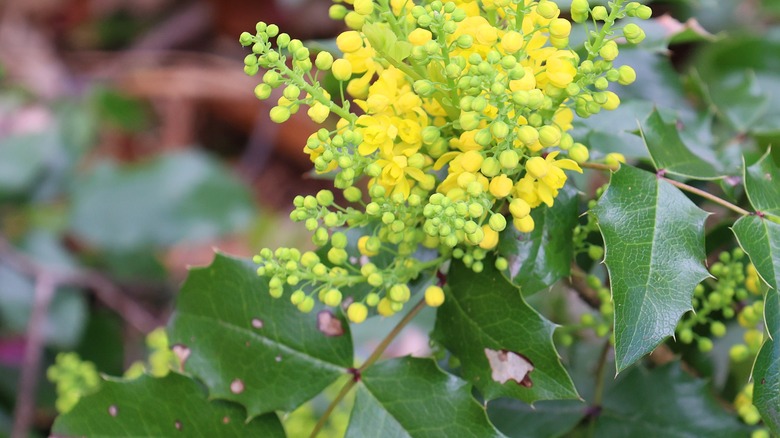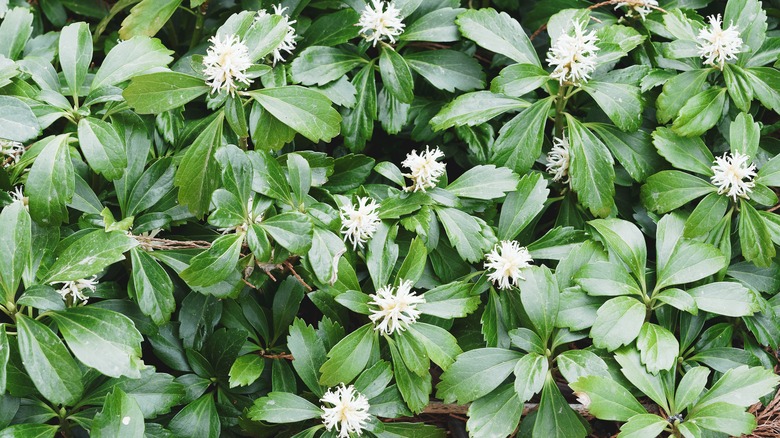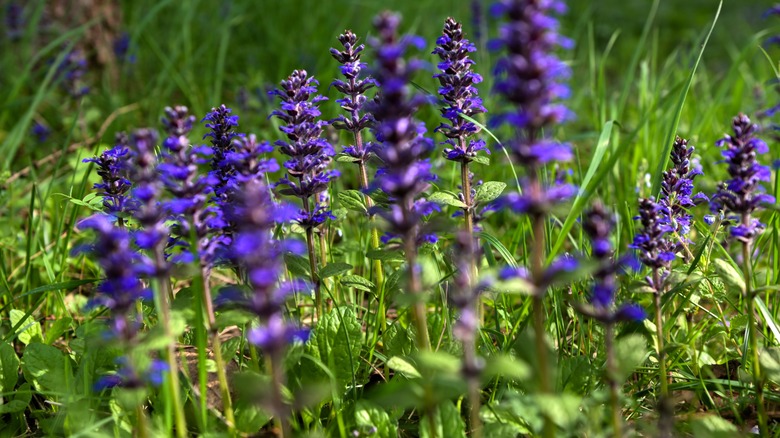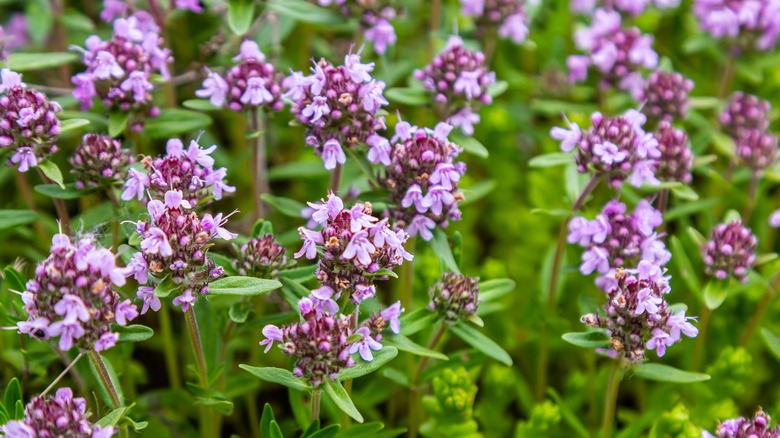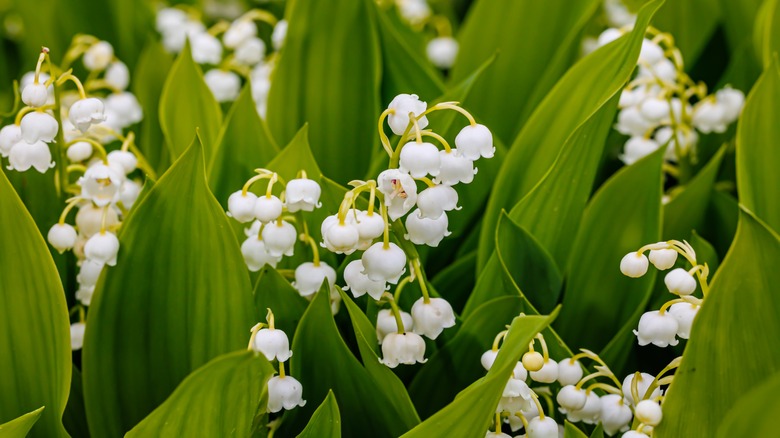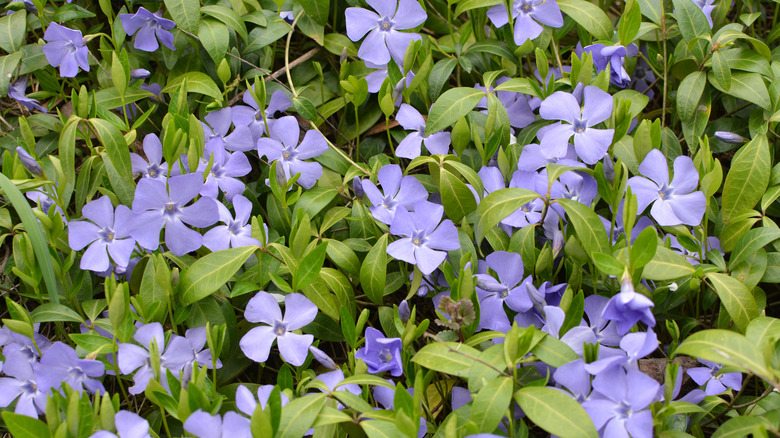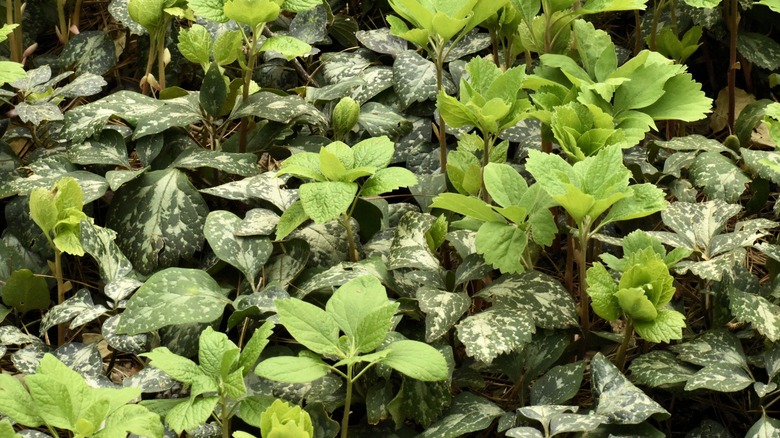10 Beautiful Ground Cover Plants That Deer Won't Touch In Your Yard
Are deer feasting on your favorite garden plants? It's a common issue in suburban and rural locations that can quickly get out of control and result in the demise of your shrubbery. One way to address this problem is by incorporating plants that keep deer away, cleverly planting them around the most visited victims to send deer running in the opposite direction. While this tactic can have some success, it's important to be realistic about its limitations. Unfortunately for gardeners, there is simply no such thing as a completely deer-resistant plant. These animals do have preferences for certain plants, but when they are hungry, there is no guarantee that any greenery will be safe from their starved snouts.
However, there are some options they prefer over others. For example, hostas and tulips are among the favorite foods of a deer, so these are best avoided. But lavender and boxwood are often skipped in the buffet line and are great to ring your landscaping in. But if you want to create a relatively large barrier around your garden or yard, then going with a sprawling ground cover is your best option. It will cover more ground without being too visually overwhelming, making it a great solution for homes plagued with visiting fawns. You can also plant it in front of garden beds filled with tastier plants, forcing the deer to wade through the expansive, off-putting cover, which might deter them. Luckily, there are many different types of ground cover that can work well for warding away deer, and they are also visually pleasing to look at. Consider options such as creeping thyme, which emits a strong spicy scent that deer don't fancy, or bugleweed, with its leathery leaves that deer prefer to bypass. Here is a closer look at your choices.
Strong-scented sweet woodruff is not inviting to deer
Sweet woodruff (Galium odorata) has long been admired for its alluring scent combination of vanilla and freshly mown hay. In the Middle Ages, it was used as a strewing herb to disguise bad smells and repel pests, like an old-fashioned version of an air freshener. Both the dried leaves and flowers can also be used as potpourri. Fortunately for gardeners, sweet woodruff isn't an aroma that deer are drawn to. As strong smells put off deer, you can utilize this attractive plant to keep the animals away from your yard. Though this plant emits the most intense perfume in its dried form, the living plant also gives off a fragrance that means deer will be unlikely to visit it.
This perennial plant forms a dense ground cover that can work well in flower beds, but it can also be a good choice for a low-maintenance, weed-resistant lawn alternative. Be aware that it can spread aggressively via underground creeping rhizomes, especially in warmer climates. It is easier to manage in cool conditions, though it is hardy through USDA zones 4 to 9.
Creeping dogwood carpet provides deer-resistant ground cover
Creeping dogwood (Cornus canadensis) is a deciduous, low-growing plant typically used as ground cover. It is commonly known as bunchberry, as a reference to the small clusters of vivid red berries it produces in summer. Creeping dogwood has many attributes that make it a popular choice for cultivating in the garden, one of which is its deer resistance. Though there is no guarantee it will be avoided by deer, creeping dogwood is widely known as a species that is seldom bothered by these animals. As a bonus, rabbits will also avoid this plant.
If your garden has been experiencing unwelcome visits from deer, plant creeping dogwood as ground cover around your shrubs and trees to help keep the animals at bay. It can grow to a height of up to 1 foot with a spread of 6 inches, so you'll need multiple plants to create the effect of a lush, green carpet. The deer-resistant ground cover is perfect for a shade garden since it thrives in low light and is suitable for growing in USDA hardiness zones 2 to 6. It provides several seasons of interest in the garden, producing white flowers through spring and summer and red berries in late summer that can persist into fall. As winter approaches, the foliage turns red before shedding.
The scent of creeping phlox discourages deer
Creeping phlox (Phlox stolonifera) is a pretty, flowering ground cover that produces a scent deer are not fond of. Though some hungry deer may nibble creeping phlox out of desperation in winter when there is less food choice, it is far from their preferred option. Along with other wildlife, such as rabbits, deer will ordinarily choose to steer clear of creeping phlox. Although the plant is great for keeping unwanted visitors at bay, it can help to attract desirable wildlife to the garden. Hummingbirds and butterflies, in particular, are among the pollinators known to be drawn to the masses of attractive flowers creeping phlox produces.
To successfully grow a creeping phlox plant, you'll need to be in USDA hardiness zones 5 to 8. The plant can spread rapidly, making it an excellent choice for filling in gaps in borders. For the best blooms, you'll want to position it in a spot where it receives at least six hours of sunlight each day, although it can also thrive in a partially shaded area. Well-draining soil is essential for a healthy creeping phlox plant because pests and diseases can become a problem in wet sites. Aim to keep the soil moist but not soaking when the plant is young. Once established, it is very drought tolerant.
Deter deer with a carpet of creeping mahonia
Creeping mahonia (Mahonia repens) goes by several common names, including 'creeping hollygrape,' 'creeping barberry,' and 'creeping Oregon grape.' Growing to around 1 foot in height, this perennial makes for a beautiful ground cover in the garden, sending out vivid lemon-yellow flowers in spring and clusters of dark blue berries in late summer. Creeping mahonia is an ideal specimen to grow in yards frequented by deer because these creatures are known to avoid feeding on the foliage, probably because the leaves have sharp spines, similar to holly. By planting this interesting ground cover, you can help discourage deer while benefitting from pollinators and birds that will be attracted to the garden.
This plant is a perfect ground cover choice for anyone who prefers a low-maintenance garden because it is super simple to care for. It is drought-tolerant and will rarely need any attention. Creeping mahonia can also adapt to most soil types, and though it thrives in partial shade, it will also tolerate full sun or heavy shade. You can expect this plant to reach around 1 foot in height, though in ideal conditions, it may extend beyond this. Creeping mahonia is a slow-spreading plant, but over time, it can grow to cover a significant area in the yard.
Shiny Japanese spurge is far from a deer's first choice
Japanese spurge (Pachysandra terminalis) is popularly planted as a ground cover for its deer resistance. This evergreen has thick and glossy foliage that can be difficult for deer to digest, so they aren't keen to snack on it. While Japanese spurge forms a dense and lush carpet of greenery that looks lovely in the garden, its aggressive growth habit can make it a problem. In fact, planting this popular ground cover could destroy your garden if you don't keep on top of it. Japanese spurge spreads quickly and, in some states, is considered to be an invasive species. However, if contained or routinely pruned, the plant can be a welcome addition to the yard, especially if you want to fill in gaps in your flowerbeds in a short space of time.
If you want to grow Japanese spurge in your garden, plant it in partial or full shade. The leaves don't respond well to being exposed to full sun, and they can suffer from scorching or bleaching. A moist and well-draining soil is best for this plant, though it can tolerate periods of drought. When caring for Japanese spurge you should refrain from overhead watering because moisture sitting on the foliage can encourage fungal growth. Disease is a common issue for this plant, often due to overly wet conditions.
The lustrous leaves of bugleweed keep deer at a distance
Bugleweed (Ajuga reptans) is the hardy ground cover that's deer-resistant and will choke out weeds. As an exceptionally fast-growing plant that forms a dense mat of foliage, utilize it in areas of the garden where you want to fill a space quickly or where weeds are becoming problematic. This plant belongs to the mint family, and as you might expect, it gives off a minty aroma. This scent, along with the leathery texture of the thick, glossy leaves, should be offputting to any nearby deer who might be on the lookout for some greenery to munch on. Bugleweed is not only a very practical plant for the garden, it is also delightful to look at. The pretty purple-blue flowers it sends out in spring are quite showy, bringing additional interest to borders and flower beds.
There is no wrong place to plant bugleweed in the garden because it tolerates all levels of light, from full sun to full shade. This makes it the perfect choice for creating a green ground cover beneath the shade of a dense tree, where many other plants cannot thrive. Though bugleweed can survive in dry conditions, it prefers moist soils, so aim to provide supplemental water in times of drought. Its need for moisture also means that well-draining soil is important to avoid root rot.
Aromatic creeping thyme won't welcome deer to the garden
The spicy scent of creeping thyme (Thymus praecox) might get your tastebuds tingling, but it has the opposite effect on deer. Since deer tend to stay away from strong smells, they rarely touch creeping thyme. This is excellent news for home gardeners because creeping thyme makes a wonderful addition to any yard. Its low-growing and spreading habit makes it ideal as an attractive ground cover, and it can also work well as a container plant or draped over the side of a rocky ledge. It sends out delicate-looking flowers all through summer in shades of pink and purple. Creeping thyme might smell delicious, but this variety of thyme is not usually cultivated as an herb for the kitchen, though it is edible.
To successfully grow a creeping thyme plant, find it a sunny spot in some well-draining soil. Creeping thyme is vulnerable to root rot, so ensuring good drainage is a good idea, though the plant is known to tolerate a wide range of soil types. Very little maintenance is required for this plant, with gentle pruning each winter being enough to keep it in good condition. Creeping thyme is a perennial plant that should be grown in USDA hardiness zones 5 to 8. At the warmer end of these zones, the plant can remain evergreen through winter, while in cooler climates, it will enter dormancy.
Deer won't touch pretty but poisonous lily of the valley
If you're trying to frighten off the local deer populations with your choice in ground cover, consider lily of the valley (Convallaria majalis). The delightful bell-shaped blooms and sweet scent emitted by this plant might fool you into thinking it is simply a pretty sight, but deer know that lily of the valley is hiding a toxic secret. All parts of this plant are highly poisonous when consumed, giving off an oniony scent that warns deer exactly what will happen if they taste. As a result, deer tend to stay far away from this gorgeous ground cover.
If you've got pets or young children who might be tempted to explore the garden with their mouths, you might want to think twice about planting lily of the valley. It can even be dangerous to touch lily of the valley, with potential resulting injuries including skin blistering, itching, or swelling. However, if you need some ground cover around the edge of your property to ward off deer, and you know it won't come into contact with anyone, then lily of the valley can work well. It thrives in shade, making it an excellent choice for creating a lush mat beneath trees and shrubs. It can tolerate a wide range of soil conditions and is hardy through zones 3 to 7.
Perwinkle foliage is offputting for fawns
Looking for a beautiful flowering plant that works as ground cover to choke out weeds, make your soil healthier, prevent erosion, and keep deer away? Periwinkle (Vinca minor) could be the garden star you've been searching for. This plant, although considered invasive in the wild, can be a wonderful addition to the yard because it has so many positive attributes. The way that periwinkle suppresses the growth of nearby plants makes it ideal for keeping weeds at bay, while the thick and glossy foliage is offputting to deer.
You want to be cautious before planting periwinkle because it does come with some risks. The plant can spread aggressively, which might be ideal if you've got a lot of ground to cover, or it might be bad news if you have a small yard that could get completely taken over. Being aware of the risks is essential so you know what you're getting into before welcoming this plant with open arms. It tolerates a variety lighting conditions, from full sun to heavy shade, but it will perform best with access to plenty of light. It's ideal for growing in USDA hardiness zones 4 to 9.
Deer stay away from Allegheny spurge
Allegheny spurge (Pachysandra procumbens), also known as 'mountain spurge,' can be deciduous or evergreen depending on the climate. Reaching a maximum of 1 foot in height and spreading via underground rhizomes makes an ideal ground cover. Allegheny spurge has a dense growth habit and will form an attractive green mat with its mottled leaves in shades of gray and purple. It is known to be very resistant to deer, who prefer to avoid touching it. If deer have been feasting on some of the trees or shrubs in your yard, plant mountain spurge around its base to help deter them.
Mountain spurge is one of the ground cover plants that love shade, so position it in dappled shade or full shade for the best growth. Avoid planting this ground cover in full sun because the leaves can suffer from bleaching. Tiny white flowers will bloom in early spring and give off a pleasant fragrance, adding interest to the landscape. Leaf blight is, unfortunately, a common issue for mountain spurge, so efforts should be taken to minimize the chance of this disease forming. Water the plant at ground level so moisture does not sit on the surface of the leaves, and thin out the plant to help increase good air circulation.
